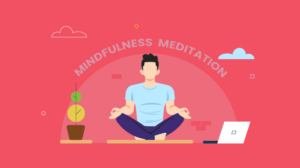

Neck tension is a common issue for many of us, particularly with long hours spent hunched over desks, staring at screens, or simply carrying the weight of everyday stress.
If you have ever caught yourself rubbing your neck after a long day or waking up with stiffness, you are not alone. One of the most powerful tools to address this chronic discomfort is mindfulness meditation.
It is a gentle, yet highly effective approach to release tension, calm the mind, and promote better posture and relaxation.
In this article, I will walk through various mindfulness techniques, including meditation practices that specifically target neck tension.
Not only will these help you relax, but they will also cultivate awareness of your body and posture, reducing the buildup of stress and discomfort.
In This Article:
- Understanding Neck Tension and Its Causes
- The Power of Mindfulness for Physical and Mental Relaxation
- Preparing for a Mindfulness Session
- Techniques to Release Neck Tension through Mindfulness
- Body Scan Meditation for Neck Tension
- Guided Visualization and Relaxation
- Breathing Techniques to Ease Neck Strain
- Incorporating Mindful Movement
- How to Make Mindfulness a Regular Part of Your Routine
- Conclusion
Understanding Neck Tension and Its Causes
Neck tension often arises due to poor posture, stress, or physical strain. Whether it is hours spent in front of a computer, long driving sessions, or emotional stress, the neck muscles are prone to tightening.
Over time, this tension leads to discomfort, headaches that give tension, and even reduced mobility.
The Mayo Clinic reports that mindfulness can effectively reduce pain and tension in chronic cases by shifting our attention inward and helping us recognize when stress begins to manifest in the body.
By becoming aware of this tension early on, you can prevent it from escalating into a more persistent issue.
The Power of Mindfulness for Physical and Mental Relaxation
Mindfulness is all about paying attention to the present moment without judgment. Research has shown that regular mindfulness meditation can alleviate both physical and emotional stress.
Studies, such as those by Fadel Zeidan, Ph.D., have demonstrated how mindfulness can reduce the activation of brain areas associated with pain, making it particularly useful for conditions like neck tension.
By practicing mindfulness, you bring awareness to your body and allow it to naturally release accumulated tension.
This is not just about relaxing in the moment; it is about training your mind and body to notice discomfort early, so you can address it before it becomes overwhelming.
Preparing for a Mindfulness Session
Before diving into specific meditation techniques, creating the right environment is essential for a successful and effective practice.
Preparing your body and mind properly can maximize the benefits of meditation, particularly for relieving neck tension and improving posture.
Here is how to set the foundation for relaxation:
Find a Comfortable Space – Choose a quiet, clutter-free environment where you can meditate without distractions. Whether it is a chair, a cushion, or a soft floor, ensure your body feels supported to prevent additional strain on the neck and spine.
Posture Matters – Proper posture is key to reducing neck tension. Sit or lie down with a straight spine, allowing your head to remain in a neutral position. According to a study in the Journal of Bodywork and Movement Therapies, poor posture during meditation can increase muscle strain in the neck and upper back.
Breathing Awareness – Take a few deep, diaphragmatic breaths to settle in. Focusing on slow, deep breathing can stimulate the parasympathetic nervous system, promoting relaxation and reducing muscle tightness in the neck and shoulders. Research in the Journal of Pain Research suggests that controlled breathing techniques help lower stress-induced muscle stiffness.
Support Your Head and Neck – If sitting, ensure your ears align with your shoulders to prevent forward head posture. If lying down, use a thin pillow or rolled-up towel to maintain natural neck curvature.
Use Guided Meditation – Beginners may benefit from using guided audio sessions that incorporate body scanning and relaxation techniques to direct focus to the neck and shoulders.
By preparing your body correctly, you create the ideal conditions for meditation to effectively relieve neck tension, promote better posture, and enhance overall well-being.
Techniques to Release Neck Tension through Mindfulness
A quick look at these facts:
Body Scan Meditation for Neck Tension:
A body scan meditation is one of the most effective ways to become aware of where tension is stored in the body.
Start by lying down or sitting comfortably. Gradually bring your awareness to different parts of your body, starting from your toes and moving upwards. When you reach your neck, focus on the sensations there—whether tightness, warmth, or pain.
Simply acknowledge them without judgment and breathe deeply into the area. Imagine the tension melting away with each exhale.
This practice helps release not only physical tension but also psychological stress.
According to Verywell Mind, body scan meditations can reduce levels of cortisol, the hormone associated with stress, making this a fantastic practice to incorporate into your daily routine.
Guided Visualization and Relaxation:
Guided meditation and mindfulness techniques often incorporate visualization to aid in releasing tension.
Picture a warm light or a gentle wave flowing through your neck, soothing and loosening the tight muscles. This visualization sends a powerful signal to your body, promoting relaxation.
If you’re short on time, a 5-minute mindfulness meditation focusing on your neck area can be highly effective. Visualizing calm and relaxation can improve muscle release just as much as longer sessions.
You can find audio guides to help you through these practices, which makes it easier to follow along and relax.
Breathing Techniques to Ease Neck Strain:
Mindfulness of breathing is a foundational technique in meditation that can be directly applied to alleviate neck tension.
Start by taking deep, controlled breaths, ensuring your belly expands with each inhale. As you exhale, visualize your neck and shoulders softening.
A ten-minute mindfulness meditation centered around breath awareness can bring significant relief. By directing your attention to how your breath moves through your body, you can consciously release tension from specific areas, like the neck.
Studies have shown that diaphragmatic breathing reduces tension in the neck and shoulder muscles while increasing oxygen flow to your muscles, enhancing relaxation.
Incorporating Mindful Movement:
Sometimes, neck tension requires not only mental relaxation but also gentle physical movement. Incorporating mindful movement sleep meditation into your routine is an excellent way to release tension before bed.
This type of practice combines slow, deliberate movements with mindfulness, helping your muscles to release stored tension.
One popular technique is a simple neck stretch synchronized with breath. Slowly tilt your head to one side while inhaling, and as you exhale, allow the weight of your head to stretch the muscles.
Repeat on the other side. Mindful movement encourages you to listen to your body and respect its limits, making it an ideal approach for releasing tension safely.
How to Make Mindfulness a Regular Part of Your Routine?
To truly benefit from these practices, consistency is key. Incorporating mindfulness into your daily routine does not require a massive time commitment.
You can start with a 20-minute guided meditation or even a bedtime mindfulness meditation to wind down at the end of the day.
The more regularly you practice, the more intuitive it becomes to identify and release tension before it takes a toll on your body.
A mindfulness-based stress management program, for example, can equip you with the tools you need to navigate life’s pressures without accumulating physical tension in your neck and shoulders.
Whether it is through simple breath awareness or longer guided sessions, mindfulness helps keep both body and mind aligned.
Conclusion
Neck tension does not have to be a constant companion. Through mindfulness meditation, you can cultivate a deeper awareness of your body and learn to release the tension that builds up over time.
Whether you choose to practice a five-minute mindfulness meditation at your desk, or engage in a full twenty-minute guided meditation session, the benefits are undeniable.
As you continue to incorporate these practices into your routine, not only will you notice a reduction in neck discomfort, but you will also experience greater mental clarity, reduced stress, and improved overall well-being.
This is how you learn to incorporate the best forward head posture fix naturally at home.
It is all about slowing down, tuning in, and giving yourself the space to breathe and release—literally.
References:


